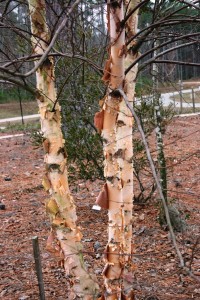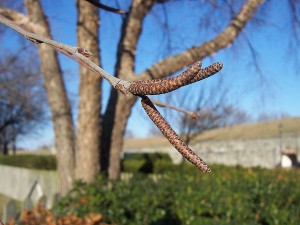River Birch – February 2015 Wildflower of the Month
 There is a lot to like about River Birch, especially in the winter when its cream to peach-colored inner shredding bark is so visible without the summer leaves. This medium-sized tree tolerates compacted clay (within reason), summer heat and drought, but grows best in average to humus-rich acidic soil in full sun or partial shade. The trunk can be single or multi-stemmed, with finely textured branches and toothed, triangular light green leaves becoming yellow in the fall. River birch is a highly prized ornamental for its graceful silhouette and attractive bark. With a tolerance for acid soils, it is also planted for erosion control.
There is a lot to like about River Birch, especially in the winter when its cream to peach-colored inner shredding bark is so visible without the summer leaves. This medium-sized tree tolerates compacted clay (within reason), summer heat and drought, but grows best in average to humus-rich acidic soil in full sun or partial shade. The trunk can be single or multi-stemmed, with finely textured branches and toothed, triangular light green leaves becoming yellow in the fall. River birch is a highly prized ornamental for its graceful silhouette and attractive bark. With a tolerance for acid soils, it is also planted for erosion control.
Each tree houses both male and female flowers, formed as brown catkins from March through April. The male pollen-bearing catkins are elongate and the female, fruit-bearing catkins are cylindric. Flowers appear March through April and fruits from May through June. The fine seeds are eaten by small birds including chickadee, goldfinch, purple finch, titmouse and nuthatch. River Birch is resistant to many pests and diseases that plague other birches.
Foundd naturally along stream and river edges from Massachusetts and southeastern Minnesota, south to northern Florida and east Texas, River Birch is native in nearly every county in Virginia. The tree is fast-growing when young and slows with age, living not more than 70 years. While of less quality than Black Birch (B. lenta) or Yellow Birch (B. alleghaniensis), the wood is strong and light, ideal for children’s toys and artificial limbs and inexpensive furniture.
While Yellow Birch and Sweet Birch have the flavor of wintergreen when crushed, River Birch is not aromatic. Native Americans used the leaves of River Birch to treat dysentery and colds and they made preparations of bark for urinary problems and for stomach pain.
By Helen Hamilton, past-president of the John Clayton Chapter, VNPS
Photos: Helen Hamilton and Phillip Merritt

